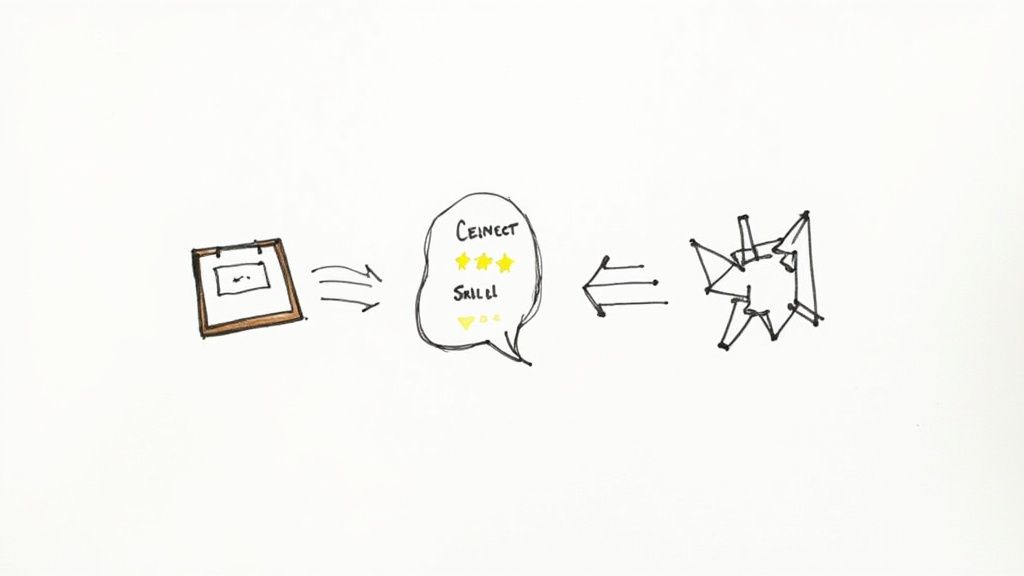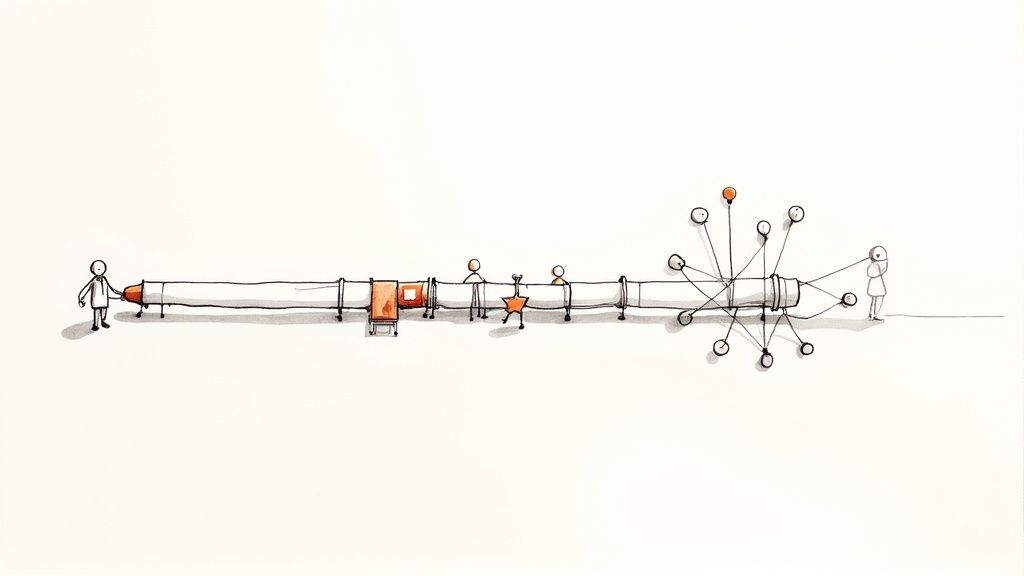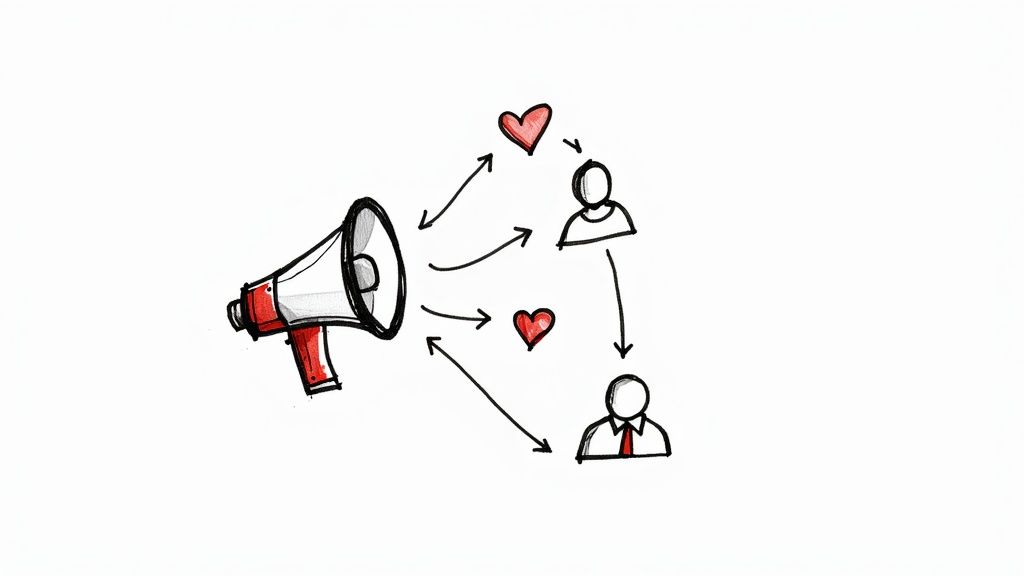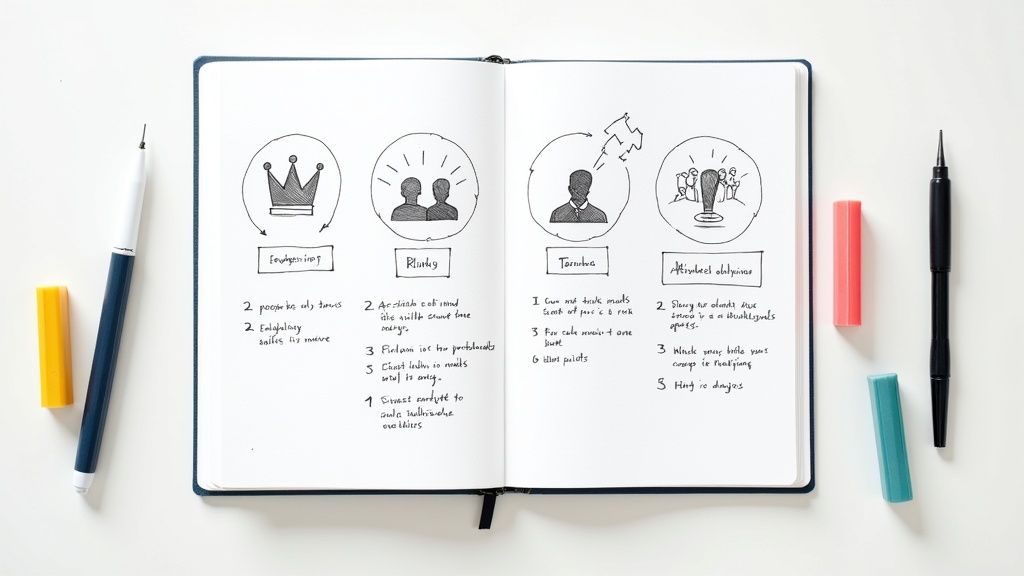Let’s be honest. Half the recruiting advice out there sounds like it was written by a chatbot that’s only ever hired imaginary friends. 'Just find the purple squirrel!' they say. 'Optimize your synergy!' they cheer from the sidelines. It’s exhausting, and frankly, it isn't working. You've sat through enough meetings, sifted through enough resumes to wallpaper your office, and probably interviewed a few candidates you wouldn't trust to water a plastic plant. You're trying to build a killer team, not collect professional-sounding hobbies. The traditional hiring playbook is broken, turning the crucial task of finding great people into a bureaucratic crawl.
The truth is, most recruiting 'best practices' are just outdated rituals we repeat because we saw someone else do them. We’re here to change that. We've been in the trenches, we've made the mistakes, and we've figured out what actually moves the needle, without having to mortgage the office ping-pong table for another software subscription. Forget the vague theories and generic tips. This article is your no-fluff, actionable guide to the eight best practices recruiting actually needs right now. We’ll cover everything from defining roles with surgical precision to building a candidate experience that doesn't feel like a trip to the DMV. Let's get to it.
1. Stop Fishing with a Giant Net. Get a Speargun.
Before you write a single line of a job description, stop. Who are you actually looking for? Too many companies just dust off an old JD, toss it onto a dozen job boards, and then wonder why they’re drowning in a sea of irrelevant applications. This isn't about being picky; it’s about being precise. It's the difference between shouting into the void and having a focused conversation with the right person.
The Problem with the "Post and Pray" Method
Sure, the giant net approach feels productive. You see a high volume of applicants and think, "Great, lots of options!" But this strategy is a time-sink. Hope you enjoy spending your afternoons fact-checking resumes and running low-quality screening calls—because that’s now your full-time job. This is a classic pitfall that undermines even the most well-intentioned recruiting efforts.
Building Your Ideal Candidate Avatar
Collaborating with your hiring manager to build a crystal-clear profile is the most boring, yet most impactful, thing you can do. It feels like homework, but it’s the cheat sheet for the entire hiring process.
Instead of just listing skills, define the outcomes.
- Bad: "Must have 5+ years of experience in project management."
- Better: "Must have a proven track record of launching at least two B2B SaaS products from concept to market, managing cross-functional teams of 5-10 people."
Actionable Tip: Host a "role kickoff" meeting with the hiring manager. Don't leave until you can answer these three questions: What does success look like in 90 days? What specific problem will this person solve immediately? What are the absolute, non-negotiable deal-breakers?
This upfront work makes every subsequent step easier. Your job description will be sharper, your sourcing more targeted, and your screening questions will practically write themselves. This is one of the most fundamental best practices recruiting teams can implement, as it sets the foundation for a successful hire.
2. Ditch the "Good Vibe" Gut Check. Build an Interview Machine.
Hiring based on a "gut feeling" is just a polite way of saying you’re relying on unconscious bias. It’s inconsistent, unfair, and a terrible way to predict future performance. A structured interview process isn’t about being robotic; it's about being scientific. It ensures every candidate gets the same shot, is evaluated on the same criteria, and that your decision is based on evidence, not just how much you liked their small talk.

The Problem with Improvising Interviews
Let's be honest, most interviews are just a series of random questions. "What are your weaknesses?" "Where do you see yourself in five years?" These questions are useless. They don't predict job success and often favor candidates who are simply good at interviewing. This leads to inconsistent evaluations, where one interviewer’s "great candidate" is another’s "maybe," making hiring decisions a chaotic mess.
Designing a Repeatable, Defensible Process
Standardizing your interview process is the single best way to reduce bias and improve hiring quality. It means every candidate for a role gets the same core set of questions, and you evaluate their answers against a pre-defined rubric. This isn’t just good practice; it's a core component of best practices recruiting and creates a defensible, fair system.
- Bad: "Let's just chat and see if they're a good cultural fit."
- Better: "We will ask all candidates to describe a time they managed a conflicting priority, using the STAR method to evaluate their problem-solving and communication skills against our rubric."
Actionable Tip: Create a question bank tied to your company values and the role's core competencies. For each question, define what a poor, average, and great answer looks like. Train your interviewers on this rubric and mandate that they submit their feedback via a scorecard before discussing the candidate with others.
3. Stop Panicking. Start Pipelining.
Most recruiting is reactive. A role opens, panic sets in, and the scramble begins. You’re forced to find the best possible person in a ridiculously short timeframe. Proactive talent pipelining is the antidote to this chaos. It's about building relationships before you need them, creating a warm bench of qualified candidates who are already familiar with your company and mission. It’s the difference between emergency-dialing a plumber and having one on speed dial.

The Problem with the "Just-in-Time" Hiring Frenzy
Waiting for a vacancy to start sourcing is like waiting for a hurricane to buy plywood. It's too late. This reactive approach puts immense pressure on your team, leading to rushed decisions, compromised quality, and an inflated cost-per-hire. You end up settling for "good enough" instead of holding out for the perfect fit, all because the clock is ticking too loudly.
Turning Recruiting from a Sprint into a Marathon
Building a pipeline isn't just about collecting resumes; it's about nurturing connections. Think of it as long-term lead generation for talent. This is how the best in the business stay ahead. It transforms recruiting from a frantic transaction into a strategic, long-term function.
Instead of just sourcing for open roles, start sourcing for future needs.
- Bad: "Sourcing for a Senior Data Analyst role that just opened."
- Better: "Building a community of top-tier data professionals in our industry by sharing insights and hosting quarterly virtual meetups."
Actionable Tip: Use your ATS or a recruiting CRM to tag and track promising candidates who weren't a fit for a past role but could be perfect for a future one. Send them a quarterly newsletter with company updates, industry news, or employee spotlights. It’s a low-effort way to stay top-of-mind.
This long-game strategy is one of the most effective best practices recruiting teams can adopt to shrink time-to-hire and dramatically increase the quality of candidates. For a deeper dive, learn more about talent pipeline management and its benefits.
4. Treat Your Candidates Like Customers, Not Commodities
Your employer brand isn’t just your careers page or the occasional LinkedIn post. It’s the sum of every interaction a potential employee has with your company, from their first impression of a job ad to the final rejection email. Top talent has options, and they're window-shopping for their next role. If your candidate experience feels like navigating a bureaucratic maze, they’ll simply take their skills elsewhere.

The Problem with a "Black Hole" Application Process
A poor candidate experience does more than just cost you a single hire; it actively damages your brand. Candidates who feel ignored, disrespected, or left in the dark are likely to share their negative experiences on platforms like Glassdoor or with their professional network. This creates a vicious cycle where your reputation repels the very people you want to attract, making every future hire more difficult and expensive.
Weaving Your Brand into Every Interaction
Your company’s mission and values should be the golden thread running through the entire recruitment journey. Don't just tell candidates you have a great culture; show them. This is a core component of best practices recruiting because it transforms a transactional process into a relational one.
Instead of vague statements, provide concrete evidence.
- Bad: "We have a collaborative and innovative culture."
- Better: "Our engineers run a weekly 'Demo Day' where anyone can share a project they’re passionate about, and our product roadmap is built on ideas crowdsourced from the entire team."
Actionable Tip: Send a simple, one-question survey to every candidate who is rejected: "On a scale of 1-10, how would you rate your interview experience?" Don’t ask for an essay. Just get the data, track your Net Promoter Score (NPS) over time, and use it to identify and fix cracks in your process. You can discover how to improve the candidate experience by implementing small, consistent changes.
5. Stop Guessing. Start Measuring.
It’s time to trade in your crystal ball for a spreadsheet. Gut feelings are great for picking a lunch spot, but they’re a terrible way to build a company. Relying on intuition alone introduces bias, creates inconsistencies, and makes it impossible to know if your hiring process is actually working or just getting lucky. Data isn't about removing the human element; it's about making the human element smarter.
The Problem with the "Gut Feeling" Method
"I just have a good feeling about this one." Famous last words. This approach is not only unreliable, but it's also unaccountable. When a hire doesn't work out, who’s to blame? The gut? This method makes your hiring process a black box, where you can't identify bottlenecks, prove ROI, or make a business case for more resources. It’s one of the riskiest best practices recruiting teams can ignore.
Turning Metrics into Momentum
Starting with data doesn't require a Ph.D. in statistics. It begins with asking simple, powerful questions and tracking the answers. This isn't just about looking busy with charts; it's about finding the leverage points that actually improve your hiring outcomes.
Instead of guessing, measure what matters.
- Vague: "We need to hire faster."
- Better: "Our average time-to-fill for engineering roles is 52 days. We need to reduce this to under 40 days by optimizing our technical screening stage, where we see a 10-day lag."
Actionable Tip: Start with the basics. Track your "Big Three" metrics for a month: Time-to-Fill, Cost-per-Hire, and Source-of-Hire. Hold a monthly meeting with your team to review this data. What's working? What's not? Where are your best candidates coming from? Let the numbers guide your next move.
This evidence-based approach transforms your recruiting function from a cost center into a strategic business partner. You stop defending your decisions and start proving their value with cold, hard facts.
6. Build DEI In, Don't Bolt It On
Let's be clear: DEI isn't a "nice-to-have" checkbox or a corporate buzzword you sprinkle into your careers page. It’s a strategic imperative. Treating DEI as an afterthought is like building a house and then trying to add the foundation. It doesn't work. Truly integrating DEI means weaving it into the very fabric of your hiring process, from the first sourcing email to the final offer letter.
The Problem with "We Hire the Best Person" Mentality
The phrase "we just hire the best person for the job" sounds noble, but it often masks a network of unconscious biases that favor candidates who look, think, and act like the existing team. This leads to a homogenous talent pool, stifled innovation, and a company culture that reflects a narrow worldview. It’s a comfortable echo chamber, not a competitive advantage.
Building DEI into Your Recruiting DNA
Integrating DEI is about designing intentional processes to mitigate bias and broaden your talent pipeline. It’s not about lowering the bar; it's about widening the gate so more qualified people can walk through. Smart companies know this isn't just a moral issue—it's a business one.
Instead of just hoping for diverse applicants, build a system that attracts them.
- Weak: "We are an equal opportunity employer."
- Stronger: "We use inclusive language tools to vet our job descriptions, partner with organizations like the National Society of Black Engineers, and conduct blind resume reviews to ensure every candidate is evaluated on their skills and potential."
Actionable Tip: Conduct a "DEI audit" of your current hiring process. Start by using a tool to analyze your job descriptions for gendered or biased language. Then, mandate that every interview panel is diverse. If you can't find a diverse interviewer internally, you have a bigger problem to solve.
These steps aren't just feel-good measures; they're essential components of best practices recruiting. By systematically de-biasing your process, you expand your access to top talent and build a more resilient, innovative, and representative team.
7. Automate the Boring Stuff. Keep the Human Stuff.
Let’s be real, half of recruiting is pure, unadulterated admin work. Chasing down schedules, sending reminders, manually screening hundreds of near-identical resumes. If you’re not using technology to automate the repetitive stuff, you’re not a recruiter; you’re a professional cat-herder. Integrating smart automation isn’t about replacing humans. It’s about freeing them up to do what they do best: build relationships.
The Problem with Manual Overload
Sticking to spreadsheets and manual email chains feels old-school, but it’s just inefficient. This approach creates bottlenecks, introduces human error, and leads to a terrible candidate experience when someone inevitably falls through the cracks. It’s also completely unscalable. The process you use to hire five people will crumble when you need to hire fifty, leaving your team buried in tasks that a simple workflow could handle.
Integrating Tech for a Human Touch
The goal is to automate tasks, not conversations. Use technology to handle the high-volume, low-impact steps so you can pour your energy into the high-impact, human ones. This is one of the most critical best practices recruiting teams can adopt to stay competitive and efficient.
- Bad: Using an AI to send a generic, automated rejection email two months after an interview.
- Better: Using an automated scheduler to instantly book interviews, followed by a personalized confirmation email from the recruiter mentioning a specific point from the candidate's resume.
Actionable Tip: Start small. Identify the single biggest time-waster in your current process. Is it initial resume screening? Interview scheduling? Implement one tool to solve that one problem. Don’t try a full system overhaul. A simple scheduling tool can save hours a week, giving you more time for actual candidate conversations.
Smart integration of tools, especially powerful recruitment automation software, ensures you spend less time on logistics and more time finding the perfect hire. This lets you scale your efforts without sacrificing the personalized touch that great candidates remember.
8. Turn Your Team into a Recruiting Engine
Your best candidates are probably one degree of separation away, sitting in your current employees' LinkedIn networks. Yet, most companies treat their referral program like a dusty suggestion box. They announce it once, offer a forgettable gift card, and then wonder why it yields nothing. A referral program isn't a passive perk; it's an active, high-return sourcing channel you need to build and manage.
The Problem with the "Set It and Forget It" Program
An unmanaged referral program dies a slow, silent death. Employees forget it exists, the process is clunky, and the rewards don't motivate anyone. It sends the message that you don't actually value their network. This is a massive missed opportunity, as referred candidates are consistently faster to hire, perform better, and stay longer. This is a core tenet of best practices recruiting: leverage the talent you already have to find more of it.
The $500 Hello
Building a systematic referral machine means treating your employees like a highly valued extension of your recruiting team. It’s less about a one-time bonus and more about creating an ongoing, engaging system. Top companies generate a huge percentage of their hires this way because they treat it like a strategic function, not an afterthought.
Instead of just a bonus, think about the entire experience.
- Bad: "Refer a friend, get $500 if they're hired."
- Better: "Get instant updates on your referral's status via Slack. Receive $250 when they pass the first interview and another $1,000 upon hiring, plus a public shout-out from the CEO in our all-hands meeting."
Actionable Tip: Launch a "Referral Sprint" for a high-priority role. For one week, double the bonus, provide employees with pre-written social media posts, and give daily leaderboard updates. This creates urgency and makes participation feel like a team sport rather than a transactional task.
Make the process so simple a person can do it from their phone in 30 seconds. When you reduce friction and increase visibility, your team will stop being passive observers and start being your most effective recruiters.
Best Practices Recruiting: 8-Point Comparison Guide
| Strategy | Implementation Complexity 🔄 | Resource Requirements ⚡ | Expected Outcomes 📊 | Ideal Use Cases 💡 | Key Advantages ⭐ |
|---|---|---|---|---|---|
| Define Clear Job Requirements and Ideal Candidate Profile | Medium – requires collaboration and detailed profiling | Moderate – involves time from hiring managers and recruiters | Higher candidate quality, reduced time-to-hire | Initial recruitment planning, roles needing precise fit | Better screening, reduces early turnover |
| Structured Interview Process and Assessment | High – standardized multi-stage process and training needed | High – time investment from interviewers and coordinators | Fairer hiring, better job performance prediction | Positions requiring rigorous technical and cultural assessment | Reduces bias, defensible hiring decisions |
| Proactive Talent Pipeline Building | Medium to High – ongoing relationship management | High – resources for networking, CRM, events | Reduced urgent hiring time, access to passive candidates | Critical roles with unpredictable demand | Builds long-term candidate pools, brand awareness |
| Employer Branding and Candidate Experience Optimization | Medium – requires marketing and consistent communication | Moderate to High – investment in branding and process improvements | Attracts quality candidates organically, improves conversion | Companies aiming to stand out in competitive markets | Enhances reputation, reduces recruiting costs |
| Data-Driven Recruiting and Analytics | High – needs tools, expertise, and continuous monitoring | High – investment in technology and skilled analysts | Objective recruiting, bias reduction, process optimization | Organizations focused on continuous improvement and ROI | Evidence-based decisions, measurable outcomes |
| Diversity, Equity, and Inclusion (DEI) Integration | Medium to High – process redesign and cultural change | Moderate to High – training and diverse sourcing | Broader talent pools, improved team performance | Organizations prioritizing inclusive hiring and culture | Expands diversity, reduces legal risks |
| Technology and Automation Integration | High – requires adoption of multiple tools and training | High – costly software and maintenance | Faster processes, scalability, improved consistency | Scaling recruiting operations and automation of admin tasks | Reduces manual effort, speeds up hiring |
| Employee Referral Program Optimization | Low to Medium – program design and communication | Moderate – incentives and promotion activities | Higher quality hires, faster hiring, improved retention | Companies leveraging existing employee networks | Cost-effective, better retention, engaged employees |
Okay, So What Now?
Alright, we’ve just thrown a lot at you. From defining your ideal candidate like you’re scripting a movie character to building a talent pipeline that doesn’t run dry, we’ve covered the core tenets of modern, best practices recruiting. It’s easy to look at a list this long and feel overwhelmed, maybe even a little defeated. Don't be.
The goal here isn't to boil the ocean or overhaul your entire TA function overnight. That’s a one-way ticket to burnout. The real secret is to stop admiring the problem and start taking small, deliberate steps. The cost of a bad hire isn't just a salary; it's lost productivity, sagging team morale, and the agonizing process of doing it all over again. Getting it right, on the other hand, is how you build a team that doesn't just meet goals but shatters them.
Your First Move: Pick One Thing
Forget trying to implement all eight practices at once. That's like trying to learn piano, Spanish, and quantum physics on the same Tuesday. It won’t stick. Instead, pick the one area that’s causing you the most pain right now.
- Is your interview process a chaotic free-for-all? Start with structured interviews. Create a consistent question bank and a simple scorecard. That’s it.
- Are you constantly starting from scratch for every new role? Focus on proactive talent pipeline building. Spend two hours a week identifying and connecting with promising individuals, even if you don't have an open role for them yet.
- Is your team drowning in resume reviews? Look at integrating technology and automation. Let a tool handle the initial screening so you can focus on the high-value human conversations.
The point is to choose one battle you can win this quarter. Mastering one of these best practices recruiting principles will create momentum. It proves to you, your team, and your leadership that a better way is possible. You stop being a reactive order-taker and start becoming a strategic talent partner. The best candidates aren't just going to magically appear; they're waiting for a company that has its act together. It’s time to show them that company is yours.
Ready to stop drowning in resumes and start focusing on what matters? Async Interview helps you automate initial screening and implement structured, unbiased interviews, freeing you up to build relationships with top candidates. Check out how Async Interview can transform your hiring process today.




